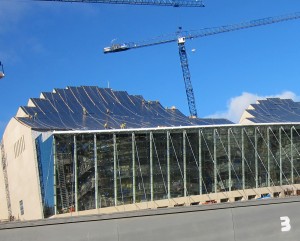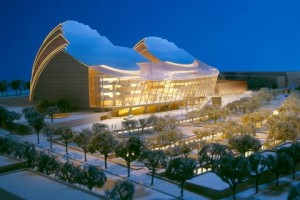PINKY SAYS: FUN FACTS AND OPINIONS ABOUT THE KAUFFMAN CENTER
The opening date for the Kauffman Center for the Performing Arts is literally no longer beyond our ken. It is time to consider what we can visibly see on the horizon and what we see can only be described as monumental, exciting and awe inspiring. If you are a resident of the Kansas City area you owe it to yourself to see an amazing sight. We did just that a few weeks ago and I can only tell you that from the first approach we made to the front of the center we were completely blown away. Try this when you go, because until you see tiny little men cavorting on the roof of the building, it is only then that you suddenly realize that the strangely interesting buildings that you see from the highway have become huge dynamic and arresting theatres that dwarf all other buildings near it.
There are many remarkable facts about the building that you should know. First of all it is 100% privately funded and 91% of the $413 million dollar budget has been successfully raised. The project is based on a 12 year timeline from its start to its completion. The land was acquired in 1999 construction began in 2006 and the grand opening is scheduled for September 2011. It contains 285,000 square feet and provides two separate performance halls. The Muriel Kauffman Theatre will have 1800 unobstructed seats. The huge stage (50′ deep x 100′ wide x 85′ tall) has the ability to produce virtually any stage production. The stage aperture can be reduced or expanded by the header which can be raised or lowered and the legs which can slide from the sides of the theatre to reduce the width. The Helzberg Hall contains 1600 seats arranged in a 360 degree seating configuration. It will contain a 5548 pipe Casavant concert organ. Both halls will have awe inspiring acoustics designed by Yasu Toyota who was responsible for the superb sound system in the Disney Hall in Los Angeles. There are no bad seats in the halls with open site lines from every seat at every price. A parking garage is attached and allows covered parking for 1024 cars. The atrium and lobby area with 17,000 square feet is the largest cable and glass enclosed structure in the world. Magnificent spaces have been provided for weddings, corporate and social events.
The Disney Hall designed by Frank Gehry has held the prime reputation for concert venues since its inception and strangely it has been a proving ground for the Kauffman Center. For example both buildings are sheathed in stainless steel , but the two halls of the Kauffman have been bead blasted to reduce the blinding shine and heat of the sun. The exterior of the building which is not steel is concrete which has been dyed to complement the limestone exteriors of the historic limestone buildings of the downtown area. The acoustic system has been tested on a sound model that was constructed of Helzberg Hall which is exactly 1/10 the size of the hall. In this manner changes have been tested and different arrangements have been made to enhance and improve the acoustics. Under each seat is a unique heating and cooling system in play that prevents the noise of huge blasts of cold or hot air. There are refreshments areas on every level. AND there are a total of 196 toilets with the ratio of 2 to 1 for women to men facilities!
Moshe Safdie, the architect, is a global citizen, urban planner, theorist and author. His building projects are worldwide ranging from Canada, India, Bangladesh, Isreal, Singapore and the United States. Safdie has produced museums, colleges, libraries, condo complexes, parks, office buildings, courthouses. He ‘has always maintained a distance from the idea of imposing a signature style which would make his work visibly recognizable. “I just never felt part of it” he says. And so starting with his Habitat project and continuing through his whole body of work his guiding principle has been to design his architecture that responds to the essence of the place and create meaningful, vital, and inclusive social spaces that will enable and enrich the community. He maintains that architecture is not about building the impossible; it is about building what makes sense for a specific need and setting. It must respond to the issues of energy, conservation, ecology, and it must weave itself into the historic cultural and social fabric of the sight. That is a tall order for any building but it seems to have been accomplished in the Kauffman Center. It’s big and its beautiful. And it is right here in River City! Congratulations to Kansas City on a project that will be recognized and applauded all over the world.




Leave a Reply